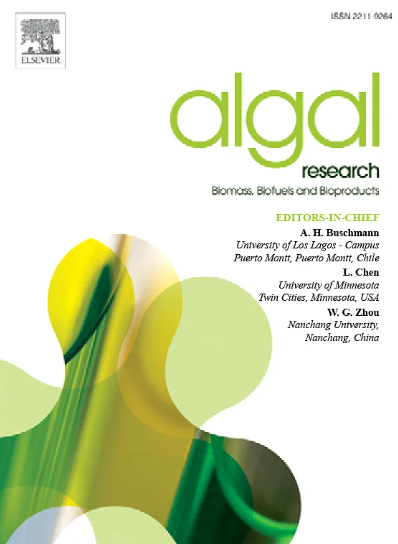Growth and photo-physiology of microalgal biofilms grown in food and piggery waste digestates
IF 4.6
2区 生物学
Q1 BIOTECHNOLOGY & APPLIED MICROBIOLOGY
Algal Research-Biomass Biofuels and Bioproducts
Pub Date : 2025-05-08
DOI:10.1016/j.algal.2025.104084
引用次数: 0
Abstract
Conventional suspension-based microalgae cultivation for treating anaerobically digested effluents (ADEs) suffers several setbacks such as inadequate light access, and expensive biomass harvesting. Biofilm cultivation is a promising alternative due to its simplicity, efficiency, and cost-effectiveness, but its applicability to a wide range of ADEs from diverse sources needs to be understood. Here, perfused biofilm approach was used to grow Chlorella sp. to treat anaerobically digested food (ADFE) and piggery (ADPE) effluents. To monitor the vitality and photosynthesis performance throughout the biofilm growth, chlorophyll-a fluorescence of the biofilm was studied in situ. Chlorella sp. grew successfully in ADPE with approximately 15 % and 12 % higher biomass yield and productivity than in ADFE. Approximately 10 % higher total ammonia nitrogen (TAN) removal efficiency was achieved in ADPE compared with ADFE. There was no difference in phosphate (up to 85 %) and COD (between 14 and 16 %) removal efficiencies in both effluents. The Chlorella species exhibited divergent photochemical mechanisms in both effluents. While it showed efficient transfer of electrons along the electron transport system in ADPE till day 10, inhibition of electron transport on day 4 was seen in ADFE, which improved later on day 10. Conversely, the efficiency of primary photochemistry (Fv/Fm) and the efficiency of water-splitting in PS II (Fv/Fo) reveal that the algae experience stress in the early stage of the culture in both effluents probably due to overcrowding or early acclimatization. The overall assessment of the Chlorophyll-a fluorescence parameters reveals more efficient photosystem activities in ADPE than in ADFE.
微藻生物膜在食物和养猪场废物消化液中的生长和光生理
传统的基于悬浮的微藻培养处理厌氧消化废水(ADEs)受到一些挫折,如光照不足和昂贵的生物质收获。由于其简单、高效和成本效益,生物膜培养是一种很有前途的替代方法,但其对来自不同来源的广泛的ade的适用性需要了解。本研究采用灌注生物膜法培养小球藻处理厌氧消化食物(ADFE)和猪舍(ADPE)出水。为了监测生物膜生长过程中的活力和光合性能,对生物膜的叶绿素-a荧光进行了原位研究。小球藻在ADPE中生长成功,生物量产量和生产力比在ADFE中分别提高了15%和12%。与ADFE相比,ADPE对总氨氮(TAN)的去除率提高了约10%。在两种废水中,磷酸盐(高达85%)和COD(14%至16%)的去除效率没有差异。小球藻在两种废水中表现出不同的光化学机制。直到第10天,ADPE的电子传递系统仍能有效地传递电子,而ADFE的电子传递在第4天受到抑制,并在第10天有所改善。相反,初级光化学效率(Fv/Fm)和PS II中水分解效率(Fv/Fo)表明,藻类在培养早期可能由于过度拥挤或过早适应而受到胁迫。叶绿素-a荧光参数的综合评估显示,ADPE的光系统活性高于ADFE。
本文章由计算机程序翻译,如有差异,请以英文原文为准。
求助全文
约1分钟内获得全文
求助全文
来源期刊

Algal Research-Biomass Biofuels and Bioproducts
BIOTECHNOLOGY & APPLIED MICROBIOLOGY-
CiteScore
9.40
自引率
7.80%
发文量
332
期刊介绍:
Algal Research is an international phycology journal covering all areas of emerging technologies in algae biology, biomass production, cultivation, harvesting, extraction, bioproducts, biorefinery, engineering, and econometrics. Algae is defined to include cyanobacteria, microalgae, and protists and symbionts of interest in biotechnology. The journal publishes original research and reviews for the following scope: algal biology, including but not exclusive to: phylogeny, biodiversity, molecular traits, metabolic regulation, and genetic engineering, algal cultivation, e.g. phototrophic systems, heterotrophic systems, and mixotrophic systems, algal harvesting and extraction systems, biotechnology to convert algal biomass and components into biofuels and bioproducts, e.g., nutraceuticals, pharmaceuticals, animal feed, plastics, etc. algal products and their economic assessment
 求助内容:
求助内容: 应助结果提醒方式:
应助结果提醒方式:


